How to dry a cellar: get rid of dampness, condensation, mold
The increased humidity in the cellar appears for various reasons. First of all, it is necessary to find out why it has increased, take measures to eliminate it, and then bring it back to normal. At the last stage, if necessary, disinfect. In any case, without proper ventilation and waterproofing, the problem will appear again and again. Therefore, before you dry the cellar, check whether the ventilation pipes are clogged, whether the waterproofing has suffered.
The content of the article
Preventing dampness
As usual, this "disease" is easier (and cheaper) to prevent than to cure. It is still being solved at the design stage:
- The material of walls and floors must have a low degree of hygroscopicity, poorly conduct water in both liquid and gaseous states. The best from this point of view is high-quality concrete - from M400 and higher. But he builds a lot. It is possible to add special substances that increase the water-repellent properties to a regular M200 or M250. (read about concrete brands and their composition here)
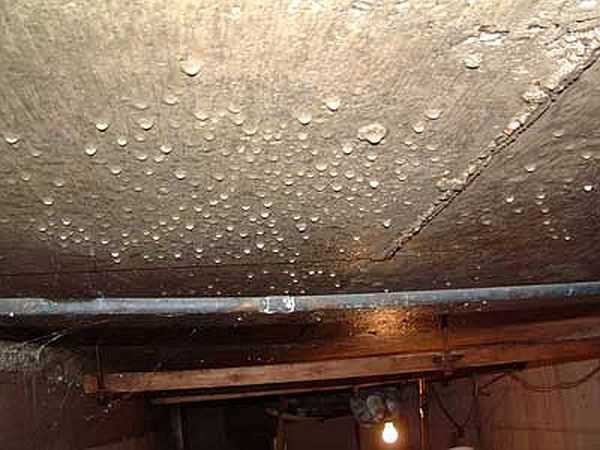
Eliminating condensation in the cellar is more difficult than preventing it from appearing
- If the groundwater level is close or in spring / autumn its level rises significantly, external waterproofing is necessary. On the outside, liquid compounds are applied to the walls (better) or rolled up (cheaper, but less effective).
- If the cellar is being built on a slope, above it it is necessary to lay a drainage pipe into the ground, which will drain the sediment flowing down the slope.
- Around the cellar (or the building under which it is located) do blind area, which removes rainfall from the roof.
- Inside the cellar, in opposite corners, there should be two ventilation pipes with a diameter of at least 125 mm. One of them ends at floor level - 10 cm higher. Through it, air flows from the street or room (supply pipe). The second ends almost under the ceiling - 10 cm below its level. This is a cooker hood. Outdoor ventilation pipes should be covered with umbrellas to keep foliage and precipitation out of them. The exhaust pipe (the one that ends near the ceiling) should be higher and it is better to install a deflector on it - to activate traction. It can be painted black: due to the heat from the sun, the traction should be better. Another subtlety: in order for the traction to be good, ventilation ducts with natural air movement must be straight. If it is necessary to bend to the side, its angle of inclination should be at least 60 ° relative to the horizon, the length of the inclined section should not exceed 100 cm.
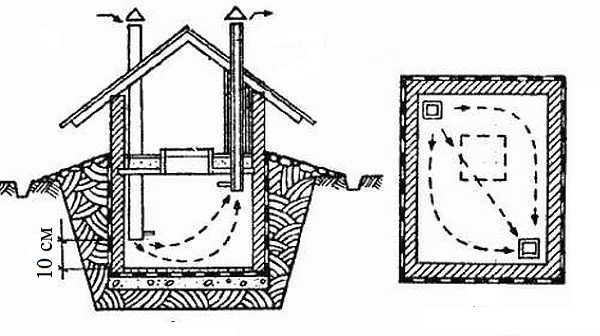
Drying out a cellar without ventilation is a difficult task. The figure shows a diagram of the organization of ventilation channels to maintain normal humidity in the cellar
- There must be a vapor barrier between the room located above and the basement to prevent moisture from entering both the basement and the basement.
Inspecting the floor
Very often in the cellar, the floor is made earthen. It is often the source of excess moisture. Through it, the moisture contained in the soil gets inside. To reduce the moisture in the cellar, you need to level the earthen floor, tamp it and cover it with a thick plastic wrap. You can use roofing material, but it breaks more often. Although it seems more durable, it breaks due to less elasticity.
It is not necessary to pour sand or earth on top of the film. Sometimes there is a lot of water in the basement (accidental flooding).Then you simply take out the film, the water partly goes into the ground, partly evaporates through the ventilation. After the dampness is gone, you can cover the floor again. If there is earth or sand on top, you will need to poke around in this slurry, extracting a film.
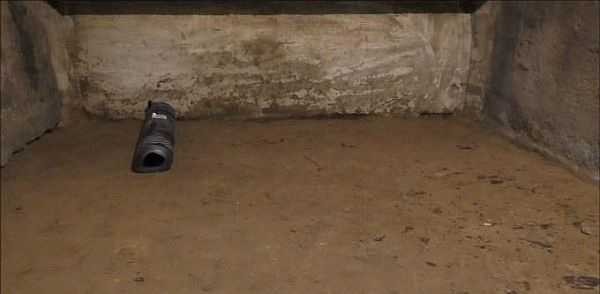
If the floor in the cellar is earthen, most of the moisture enters through it.
If, after laying the film, the humidity level in the cellar has dropped, then you have found the reason. You can leave everything as it is, only periodically change the "flooring", or you can make a concrete floor with full waterproofing. The choice is yours. To prevent the film from tearing when walked on, knock down wooden shields and throw them on the floor.
Improving waterproofing
The second reason why humidity rises in the basement is an insufficient degree of vapor barrier or waterproofing of the walls. This usually occurs if the cellar is lined with bricks, especially silicate bricks. The material is very hygroscopic and passes water vapor well. They settle in drops on the ceiling and all objects.
The problem can be solved if you make good external waterproofing: dig out the walls and apply bitumen mastic in two layers. It used to be coated with resin, but the mastic is more effective and easier to handle.
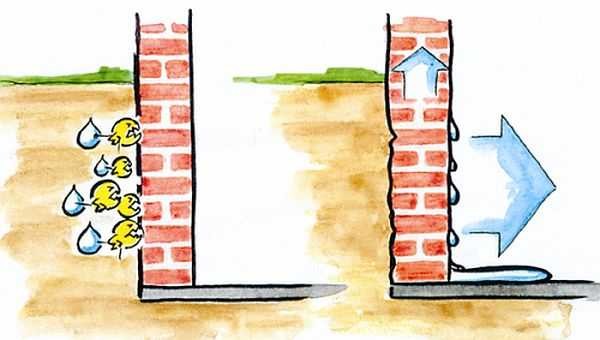
Brick walls require additional waterproofing
But earthwork is not always a joy, and it is not always possible to dig out the walls. In this case, you can make the internal waterproofing of the walls of the cellar. For this, there are cement-based impregnations: Pnetron, Kalmatron, Hydrotex, etc. They penetrate to a depth of up to half a meter into the thickness of the material (concrete, brick, etc.) and block the capillaries through which water seeps. Water permeability decreases significantly. Their only drawback is the price. But they are really effective.
All of these measures will prevent high humidity in the basement. But what if there is already moisture, how to dry the cellar? Next, let's look at ways to reduce humidity.
How to organize drip irrigation of the garden yourself, read here.
Preparatory work
All supplies are taken out of the basement, as well as all wooden structures, they are well cleaned. On the street they inspect wood - shelves / boxes / boxes. If they are not damaged, and there is no fungus or mold, they are simply laid out in the sun to dry.If there are traces of damage, the wood is impregnated with a solution of copper sulfate (concentration 5-10%, no more).
Whitewashing with lime gives good results - it will also "collect" moisture from the air. Therefore, before draining the basement, it makes sense to whitewash everything. Only they do it differently from the outside. You need to apply a thick layer of lime to the walls. To do this, make a bucket of thick whitewash, add a little diluted copper sulfate. He is an excellent disinfectant, but the concentration should not be higher than 5%, maximum - 10. The resulting thick liquid is poured in half into two containers.

This is what a paint brush for whitewashing looks like
The first half is lowered into the basement, dressed in old clothes, put on glasses, covered their hands. They take a paint brush for whitewashing (it looks more like a small broom) and it is well coated on the corners. Then with a brush you spread the liquid and spray it on the walls and ceiling. Just dip it in the thick whitewash and spray it on the walls. They are covered with drops, bumps of lime.
After everything is covered with lime, wait a day until it dries. Repeat everything with the second bucket. As a result, the walls and ceiling are porous and uneven. But condensation rarely hangs on them: lime keeps moisture inside well. After the lime has dried, you can start drying the cellar.
Do-it-yourself greenhouse construction is described here.
Basement drainage with ventilation
Sometimes it happens like this: it was dry in the cellar, and suddenly dampness appeared. One of the reasons is poor ventilation. First of all, check the cleanliness of the ventilation ducts. Clean if necessary. If everything is fine, but the dampness does not go away, then the chimney is not working well. This happens when the air in the cellar is colder than outside.Heavy and cold, he himself will not climb the pipe. A seemingly paradoxical situation arises: it was cold and damp outside - it was dry in the cellar. It got warmer - drops of moisture hung on the ceiling, walls and objects, a musty smell appeared. In this case, in order to dry the cellar, it is necessary to activate the movement of air. There are several solutions.
- Put a powerful fan on the chimney to draw air. Ensure the flow of air masses - open the hatch, if any - windows or dampers. In a few days (from three to ten) everything will dry.
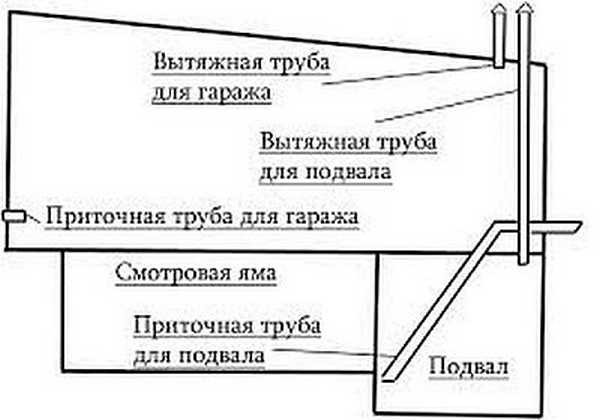
Organization of basement ventilation in the garage with a viewing hole
- Use the old "old-fashioned method" with a candle. It is suitable if there is no electricity and there is nowhere to turn on the fan. This happens if the cellar is built separately, on the street. To dry it, temporarily grow it into the exhaust pipe (the one that ends under the ceiling) so that it almost touches the floor (5-10 cm higher). A burning candle is slipped under it, but it is placed on some kind of non-combustible base. Due to the fact that the air in the pipe heats up, there is a normal draft, pulling raw air from the floor. Change the candle until the basement dries out. You can use dry alcohol tablets instead of candles. Sometimes the flame of a candle is not enough to start the movement of air. Then first slip a piece of burning newspaper into the pipe (just carefully, do not burn or melt the ventilation), after it has burned out, move the burning candle forward.
Sometimes the increased air movement leads to the fact that the humidity in the cellar does not decrease, but increases. This can often be seen in hot weather. The reason is this. The heated air carries with it a significant amount of moisture in the form of vapor. Getting into a cool cellar, the air cools down, and moisture condenses on the coldest surfaces: the ceiling, walls, sometimes on shelves and banks. If you have just such a case, then stop ventilation. You even close the supply pipe and close the lid well, limiting the flow of warm air.
How to dry the cellar in this case? Wait until autumn, and when there is no rain yet, but the temperature is already about + 10 ° C, start ventilation using one of the methods suggested above. Works. If your nights are cold in summer, you can turn on the fan at night, and close the ventilation ducts during the day. So gradually you can reduce the humidity in the cellar in summer.
We heat the cellar
If it is necessary to remove dampness even during warm weather, and ventilation only worsens the situation, you need to heat the air in the basement so that it goes outside, taking away moisture (the higher the air temperature, the more vapors it can contain).
To do this, take an old bucket or other metal container of about the same volume. They make many holes in it (you can use an ax) in the bottom and walls. Such a leaky bucket is tied to a cable (fasten securely). Coals for kebabs are poured inside (you can burn it yourself), the bucket should be almost full. The coals are kindled and stable combustion is achieved (to accelerate the combustion, you can adapt the vacuum cleaner by turning it on for blowing). A bucket with embers is lowered on a cable into the cellar, fixed so that it hangs above the bottom, and the lid is closed.
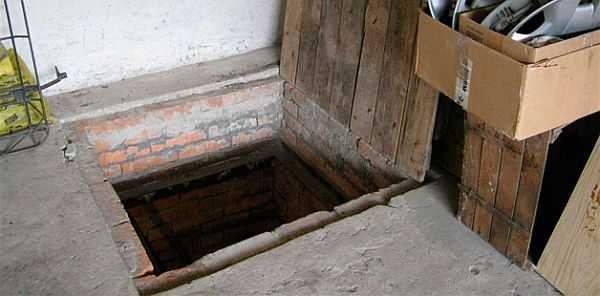
The lid on the cellar in the house should be practically airtight
Periodically, the cellar lid must be opened, letting in an additional portion of oxygen (every 20-30 minutes). You can put a fan on the supply pipe or periodically turn on the same vacuum cleaner. If the coals still go out, they are kindled again.
Attention! It is better not to climb inside, to do everything from above. Firstly, the temperature there is high (in the room about 2 * 3 meters about 70 ° C), and secondly, smoke and, possibly, carbon monoxide accumulates inside.
As the coals burned out, the bucket was taken out, the lid was closed. Do not look inside for three days: smoke and gases will kill the mold and at the same time with drying you will disinfect your cellar.Usually one such "furnace" is enough to dry out the basement in the house or on the street. Likewise, you can get rid of dampness in the basement under the garage.
Sometimes coke or coal is used instead of charcoal. It gives a higher temperature and takes longer "processing", but it burns more difficult, requires more oxygen, often forced blowing (adapt the old vacuum cleaner and corrugated hose, but turn it on for blowing). But the temperature rises even higher and dries even more efficiently. But the price of coke is high, even though buying a bucket will not go broke.
Instead of a bucket of burning coal, other heaters can be used:
- a propane burner (lower the burning one on the wire, make sure that it does not light anything and leave it hanging in the middle, as tired of it, close the valve, you can open the lid only after a day);
- a heat gun of decent power (3-5 kW);
- kirogas;
- lower the potbelly stove into the basement and heat it.
All these methods can be used, but you have to go down into the cellar in order to ignite the pyrogas or potbelly stove. And this is an unsafe undertaking and do not use this method alone. You need someone to belay you upstairs. Regarding the heat gun: it is also better to lower it by tying (tied) with a rope, and not to lower it yourself.
How to dry a basement in a garage is described in the video.
How to make high beds (to increase yields) read here.
How to dry a cellar without ventilation
If ventilation was not done during construction, it is advisable to arrange it now. At least some: getting rid of dampness will be easier. Better, of course, two pipes - one for the inflow, the second for the outflow - as described at the beginning of the article. If the cellar is made separately on the street, it is easier to organize: they pierced the ground and the roof of the cellar, inserted pipes, poured everything with concrete mortar.
With a garage it is more difficult, but here nobody clings to aesthetics. But if the basement is without ventilation under the house, it is more difficult to do everything: it is better not to break the foundation, and you cannot stretch many pipes through the floor into the room. Even so, make at least one pipe. Even through the lid, take it out into the wall or ceiling, put a supply and exhaust fan. It can be turned on now for supply, then for the hood and in this way at least somehow dry the cellar.
With at least such ventilation, you can use any of the methods described above. You can also try to collect more moisture. For this inside lay out hygroscopic materials:
- Pour dry sawdust as soon as it gets wet - throw it out, fill it with new ones. Drying this basement will not dry out, but it will lower the humidity. There will be no condensation drops on the ceiling.
- Slaked lime. Unfolded around the perimeter, along walls and on shelves. It not only collects moisture, but also kills fungi in pairs.
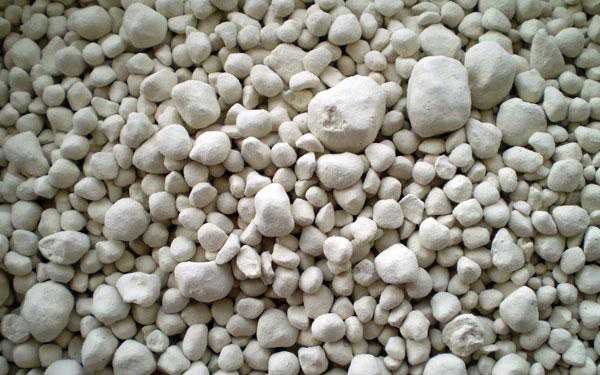
Slaked lime can be used to reduce moisture in the cellar
- Calcium chloride. 1 kg of dry matter absorbs 1.5 liters of water. You buy a few tens of kilograms, lay it out, collect it in a day, heat it up (heat it up) and can be used again. But you also need to work carefully: chlorine and calcium fumes are also toxic.
- Dry cardboard boxes. Ironically, they also absorb moisture well. You put a few dry ones, after 12-20 hours they are so wet that they almost creep in your hands. Throw it away, throw in new ones. Cheap and cheerful. Drying the cellar will not dry out at all, but it will collect condensation from the ceiling and walls.
If all these dances with tambourines do not inspire confidence in you (although they work), you can dry the cellar using modern technology. There are such household appliances - household dehumidifiers... They are often placed in swimming pools to get rid of dampness in the room. You will need a medium power model. They cost about 20-30 thousand rubles, they work from a household network of 220 V. In the process, they collect moisture from the air into a special container. You will need to drain the water periodically.
Disinfection and fight against fungi and mold
The increased humidity in the cellar leads to the fact that mold, fungi of different types and colors appear on the walls, shelves and ceilings, and all this beauty is accompanied by "aromas". In this case, all that can be taken out of the cellar is taken out and laid out to dry. After drying, whitewash wooden shelves, boxes, boards, racks with lime with the addition of a solution of copper sulfate. Better twice.
In the cellar, clean off all growths from the walls and ceiling, whitewash with lime with copper sulfate twice (the technology is described at the beginning of the article). Before the main drying, special measures can be taken to destroy the spores (or neutralize them for a while).
Lime vapor
Put the barrel in the cellar and sprinkle with quicklime. Lime is taken at the rate of 3 kg per 1 cubic meter of volume. In a barrel of lime, there should be a maximum, a little more than half. Pour water over everything. Do not interfere. Crawl out quickly and tightly (hermetically) close the lid and all ventilation ducts. You can open it in two days, ventilate well, then you can go down.
Repeat the treatment after 7-10 days. Lime vapor should burn out mold and fungi, destroy insects and their larvae. They also deal with the odors of dampness and musty very effectively. True, the cellar will smell of lime for several days.
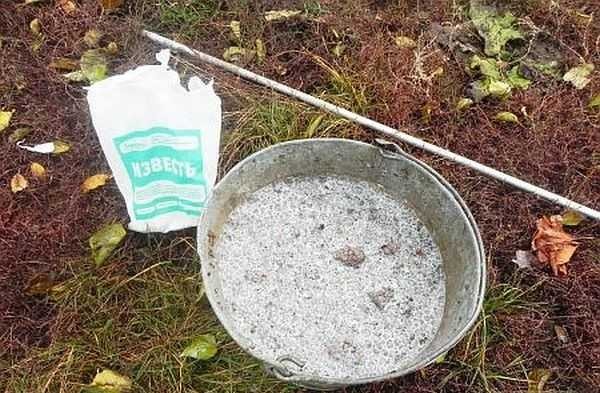
Disinfection of the cellar with lime vapor
Sulfur (smoke) bombs
Use a sulfur checker. They are sold in stores selling seeds or household stock. Each has instructions. But, in short, you need to act according to the following scheme:
- take out all metal things, if this is not possible, cover them with a layer of grease - grease or something similar.
- You set fire to the wick of the sulfur checker, it starts to smolder.
- Come out quickly, close the lid and ventilation ducts, leave it for 5-6 hours.
If the basement is in the house, it is advisable to leave it during processing: a couple of breaths with insufficient tightness and the lungs will need to be put in order for a long time.
Disinfection occurs due to the formation of sulfuric acid. It is obtained by the reaction of sulfuric anhydride and water. Therefore, mold is more efficiently killed with a sulfur checker in wet cellars.
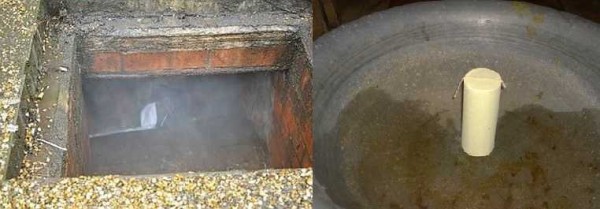
A sulfur stick is placed on metal, set on fire, quickly exited and all holes are closed
After 5-6 hours (or after the time indicated on the package), open the ventilation channels and the lid (in this order). Leave it open for at least 12 hours. Remains of gases disappear during this time. You can go in.
From the experience of operating such checkers, we can say that they need to be lit twice as much as normal. Then everything will really be neutralized.
Mold remover
Sometimes white fluffy growth appears on wood or walls. This is a type of fungus. It can be dealt with by the methods described above, but if only it is present, you can find on the construction market a means for removing solid polyurethane foam (sold in the same place as foam). Insert the tube into the assembly gun and apply to the places with the fungus. It instantly begins to roll up. And then at this place does not appear.
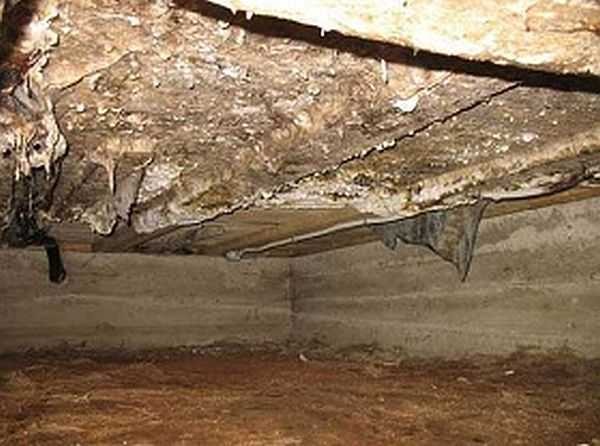
You can get rid of this evil with a polyurethane foam remover
Spreading on the floor
If you have an earthen floor, lay a thick plastic wrap on it (for which - described above), knock down wooden grates and throw them on the floor. Scatter slices of slaked lime under them. And they will collect moisture and create "bad" conditions for fungi.
How to dry a basement after flooding
If the flooding was accidental, you need to pump out the water in any available way, and then proceed according to the standard scheme:
- Take out everything you can from their cellars.
- Leave all lid and air vents open for a while.
- When more or less dry, remove debris, fungi, mold from the walls and floor.
- Whitewash with lime.
- Dry in one of the ways.
If the flooding is periodic - in the spring, for example, it will be necessary to make a full-fledged drainage system, and this is a separate conversation.
All of the above methods of how to dry a cellar are mostly based on practical experience. They are used everywhere and very often. In one case, one method works, in the other, another. Your task is to find the most effective one for your situation.

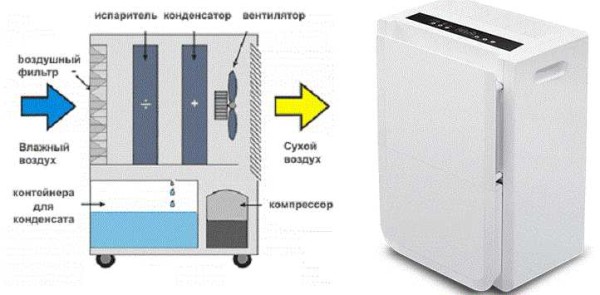

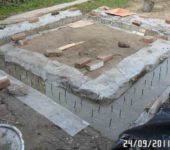






I used to use conventional air fresheners in such cases. But, you understand, they need to be used often, because their time of action is fleeting. Friends advised odorgon, and now this problem is completely solved!
Cool basement - 2 videos !! Well done Man is the owner.
We have a 1.5 x 1.5 m underground floor in our dacha a little damp. . We want to eliminate it completely. Tell me how to do this? Thank you!
cover with sand
It is logical, because the sand practically does not shrink.
For additional effect, add iron vitriol to lime with copper sulfate.